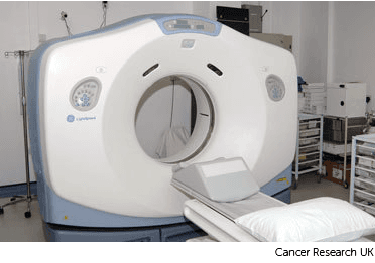Treatment for cancer of unknown primary (CUP)
Most people with CUP have radiotherapy to help control symptoms caused by the cancer, such as pain or breathing problems. This is called palliative treatment.
In some cases, you might have radiotherapy to try to cure the cancer. For example, if you have cancer spread in the lymph nodes in the neck. You may have the radiotherapy on its own or after surgery.
You might have it as a one off treatment if you are having it to control symptoms. Or you might have it as a course of treatments over a number of weeks if you are having it to try to cure the cancer.
You have a planning session with your radiotherapy team a few days or weeks before you start treatment. This means working out the dose of radiotherapy you need and exactly where you need it.
Your planning appointment takes from 15 minutes to 2 hours.
You usually have a planning CT scan in the radiotherapy department.
The scan shows the cancer and the area around it. You might have other types of scans or x-rays to help your treatment team plan your radiotherapy. The plan they create is just for you.

Your radiographers tell you what is going to happen. They help you into position on the scan couch. You might have a type of firm cushion called a vacbag to help you keep still.
The CT scanner couch is the same type of bed that you lie on for your treatment sessions. You need to lie very still. Tell your radiographers if you aren't comfortable.
You might need an injection of contrast into a vein in your hand. This is a dye that helps body tissues show up more clearly on the scan.
Before you have the contrast, your radiographer asks you about any medical conditions or allergies. Some people are allergic to the contrast.
Once you are in position your radiographers put some markers on your skin. They move the couch up and through the scanner. They then leave the room and the scan starts.
The scan takes about 5 minutes. You won't feel anything. Your radiographers can see and hear you from the CT control area where they operate the scanner.
Read more about radiotherapy in our general treatment section
Your treatment team might make a mask for you if you are having radiotherapy to your head and neck area. They are also called radiotherapy shells.
Your treatment team will make one for you to wear during your treatment sessions. It will help you to keep very still when you have radiotherapy.
The radiographers make marks on the mask and use the marks to line up the radiotherapy machine for each treatment.
The process of making the shell can vary slightly between hospitals. It usually takes around 30 minutes.
You need to wear clothes that you can easily take off from your neck and chest. You also need to take off any jewellery from that area.
Facial hair, long hair or dreadlocks can make it difficult to mould the shell. The radiotherapy staff will tell you if you need to shave or to tie your hair back.
A technician uses a special kind of plastic that they heat in warm water. This makes it soft and pliable. They put the plastic on to your face, neck and chest so that it moulds exactly.
After a few minutes the plastic gets hard. The technician takes the mask off and it is ready to use.

You might have to wait a few days or up to 3 weeks before you start treatment.
During this time the physicists and your radiotherapy doctor (clinical oncologist) decide the final details of your radiotherapy plan. They make sure that the area of the cancer will receive a high dose and nearby areas receive a low dose. This reduces the side effects you might get during and after treatment.
Radiotherapy machines are very big and could make you feel nervous when you see them for the first time. The machine might be fixed in one position. Or it might rotate around your body to give treatment from different directions. The machine doesn't touch you at any point.
Before your first treatment, your will explain what you will see and hear. In some departments, the treatment rooms have docks for you to plug in music players. So you can listen to your own music while you have treatment.

Your radiographers help you get into position on the treatment couch. They line up the radiotherapy machine, using the marks on your skin.
Then they leave you alone in the room for a few minutes for the treatment. This is so they aren't exposed to radiation.
You need to lie very still. Your radiographers might take images (x-rays or scans) before your treatment. This is to make sure that you're in the right position. The machine makes whirring and beeping sounds. You won’t feel anything when you have the treatment.
Your radiographers can see and hear you on a CCTV screen in the next room. They can talk to you over an intercom and might ask you to hold your breath or take shallow breaths at times. You can also talk to them through the intercom or raise your hand if you need to stop or if you're uncomfortable.
This type of radiotherapy won't make you radioactive. It's safe to be around other people, including pregnant women and children.
You might have to travel a long way each day for your radiotherapy. This depends on where your nearest cancer centre is. This can make you very tired, especially if you have side effects from the treatment.
You can ask your radiographers for an appointment time to suit you. They will do their best, but some departments might be very busy. Some radiotherapy departments are open from 7 am till 9 pm.
Car parking can be difficult at hospitals. Ask the radiotherapy staff if you are able to get free parking or discounted parking. They may be able to give you tips on free places to park nearby.
Hospital transport may be available if you have no other way to get to the hospital. But it might not always be at convenient times. It is usually for people who struggle to use public transport. Or who have any other illnesses or disabilities. You might need to arrange hospital transport yourself.
Some people are able to claim back a refund for healthcare travel costs. This is based on the type of appointment and whether you claim certain benefits. Ask the radiotherapy staff for more information about this and hospital transport.
Some hospitals have their own drivers and local charities might offer hospital transport. So do ask if any help is available in your area.
The side effects of radiotherapy depend on which part of your body is treated. For example, radiotherapy to the neck can cause a sore throat and difficulty swallowing. Whereas radiotherapy to the tummy (abdomen) or pelvis, can make you feel sick or have loose poo (diarrhoea).
You might feel tired while having radiotherapy. This is more likely if you are having treatment over a number of weeks.
The side effects tend to come on as you go through your course of treatment. If you have a short course of treatment of only a few days, you might have very few side effects. The side effects gradually disappear in the days after your treatment has finished.
Last reviewed: 08 Aug 2024
Next review due: 08 Aug 2027
Cancer of unknown primary (CUP) means that cancer spread (secondary cancer) has been found in your body, but doctors don't know where the cancer started (the primary tumour).
Treatment for cancer of unknown primary (CUP) can include chemotherapy, targeted cancer drugs, radiotherapy or surgery. You may also have treatment to control any symptoms you are experiencing.
Chemotherapy uses anti cancer (cytotoxic) drugs to destroy cancer cells. You might have chemotherapy to treat cancer of unknown primary.
Read about the latest research into cancer of unknown primary (CUP) and see how you can take part in a clinical trial.
Advice and support is available to help you cope with cancer of unknown primary (CUP) and its treatment.

About Cancer generously supported by Dangoor Education since 2010. Learn more about Dangoor Education
Search our clinical trials database for all cancer trials and studies recruiting in the UK.
Meet and chat to other cancer people affected by cancer.
Questions about cancer? Call freephone 0808 800 40 40 from 9 to 5 - Monday to Friday. Alternatively, you can email us.